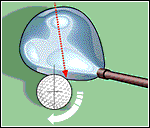 | ||
 | ||
 | Home | |
 | Ball | |
 | Club | |
 | Swing | |
 | Club-ball physics | |
 | Ball in flight | |
 | Product Spotlight | |
 | Bibliography | |
 | ||||
| [Physics of the Club-ball interaction] | ||||
 | ||||
 |
 | |||
|
The interaction between the club head and the ball will determine how far the ball will go and in which direction. There is a relationship between the speed of the club head and the initial velocity of the ball. This relationship depends on the coefficient of restitution of the ball, which varies between different types of balls. When the ball is struck by the club, it is deformed and flattened by the force of impact (balls with harder cores deform less than softer balls). In general, a harder ball will travel further than a softer ball because it deforms less and will efficiently transfer more energy from club to ball. During the impact between the ball and club head, kinetic energy is transferred and stored as the ball tries to regain its original shape. This coefficient of restitution is quite similar to the restoring force we discussed in class. To obtain maximum distance in the drive, a ball must be selected that maximizes restitution for the club speed. If the chosen ball is too soft for the club speed, too much energy will be spent deforming the ball and not enough energy will be stored in the ball. Similarly, if the ball is too hard for the club speed, then the ball will not deform enough, and again, will not transfer adequate energy. This is why it is important to choose a ball that matches the club speed. Here is a graph relating initial velocity of the ball with club speed:
There are three main elements which, in theory, determine the distance a ball travels. This neglects the effects of wind/air resistance. The distance a ball travels will be determined by the initial speed of the ball, the angle at which it is hit into the air, and any spin that has been imparted on the ball by the club. Good backspin on a ball will cause lift and yield a longer shot, while poor spin may cause the ball to slice to the right or hook to the left. From simple physics we all know that a greater initial velocity and larger initial angle will produce a longer shot, although once your angle gets too large, then your distance will start to decrease again. The optimum angle for a simple trajectory problem to achieve maximum distance is 45 degrees. However, with golf, because of the spin on the ball, air/wind resistance, and other factors, this angle is generally less (for maximum distance) and varies from one situation to another. Here is a diagram of these three keys to maximize distance:
Now letís look at spin more closely. To produce a hook (ball veers left) or a slice (ball veers right) a golfer must change his stance and the way that he hits the ball. | ||||
 | ||||






